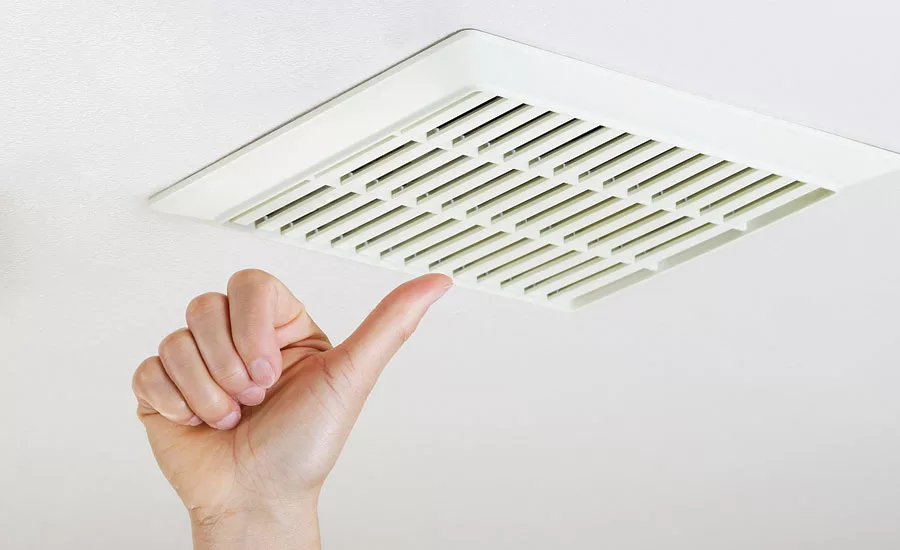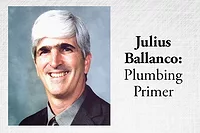Ventilate to control bathroom humidity and odors

I will admit that this column is not about plumbing — it is about addressing the consequences from plumbing. When I wrote a whimsical column in 2014 about installing a shower without any curtains or doors, one of the themes was designing the shower to avoid a cold breeze while showering, or immediately after showering.
My submitted column had a line regarding bathroom ventilation, with a follow-up that read, “That’s a story for another column.” My editors deleted that line, as they probably should have.
Well, since that column, I keep getting inundated with, “How do you ventilate a bathroom without creating a cold breeze?”
The two things plumbing fixtures produce on a daily basis are increased humidity and odor. The humidity comes from showers, bathtubs and whirlpool tubs, while odor comes from defecating or urinating. Both plumbing consequences have been dealt with in the same manner: Add an exhaust fan.
The interesting fact is that the plumbing contractor neither designs nor installs the exhaust fan. Yet the plumbing contractor is often blamed for excess humidity or poor odor control. Perhaps the plumbing contractor should be more involved in making sure a bathroom ventilation system is properly designed and installed.
There is an old adage, “The solution to pollution is dilution.” This was debunked years ago when the dilution increased pollution levels. However, when dealing with bathroom or toilet room air, you can still say the solution to odor and humidity is dilution. Actually, there are three ways that we treat odor and two ways that we treat humidity.
For odor, we can mask it, remove it or dilute it. For centuries, people have masked body odor by putting on perfume. Now we use deodorant. Similarly, in a bathroom or toilet room, one of the means of masking odor is adding a more pleasant odor to the room. There are many odor-masking systems installed in commercial toilet rooms throughout the world.
The common means of odor control in this country is to remove it or install an exhaust fan that removes it. Then we attempt to place the exhaust fan as close as possible to the odor, assuming we can capture it quickly.
Finally, we can dilute the odor. If you had fresh air, the odor fades to the point that eventually you will not smell it. That was the original way of treating toilet room odors, going as far back as the outhouse. It is called natural ventilation, or opening a window or door.
For humidity, we cannot mask it, so we either remove it or dilute it. Both work. Removal is commonly done by placing an exhaust fan as close to the source of humidity as possible. Other removal techniques include a dehumidifier.
Dilution is also a very good means of dealing with humidity. For example, if you have a room with 50% humidity and you double the size of the room, the humidity drops to 25%. Okay, I’ve oversimplified it, but you get the idea.
The ventilation for a bathroom required by the Mechanical Codes is based on odor removal, not humidity control. Small exhaust fans cannot control humidity unless they run for 20 minutes longer than a person takes a shower. Hence, a small ventilation fan should always be on a timer. If not, you will have humidity problems.
My good friend, Dr. Joseph Lstiburek, has a great line that I will steal: “Moisture goes to the cold.” Rather than using high falutin’ engineering terms, this explains concerns with moisture very simply.
When you shower, you notice that the windows and mirrors fog up. They are colder surfaces, hence, the humidity or moisture moves to their surface. In a bathroom, we need to control the moisture so it doesn’t move to the outside walls or ceiling and play havoc with the building materials.
Removal and dilution are the best forms of control. But, the exhaust rate has to be higher or longer than the Mechanical Code minimum rates. If you increase the rates, you increase the air currents that can flow by you when taking a shower. Hence, you get an uncomfortable cold breeze. The way to avoid this phenomenon is to locate any exhaust fan away from the shower and away from the shower entry.
Builders often think that the way to control humidity is to locate the fan close to the shower or even above the shower enclosure. That would be great if the fan exhausted a huge amount of air to capture all of the humidity. But, that is not what is installed. As a result, the real controlling factor is dilution with removal.
When you dilute and remove, it doesn’t matter where you locate the exhaust fan. At that point, the fan is just exchanging air or diluting the humidity. As the fan continues to run and the source of humidity ceases (you turn off the shower), dilution and removal control the moisture so there isn’t damage to the building materials.
One other factor that is not often considered is that, without a shower curtain or door, the area around you heats up equally. Hence, when you finish your shower, you don’t feel a cool breeze. Did you ever notice that when you open the shower door or curtain while still wet you feel a breeze? What is happening is the heat is moving to the cold. Simple heat transfer analysis. If there is no immediate change in temperature, there is no feeling of a breeze.
My original article talked about the walk-in shower I installed in our master bathroom. After four years of use, there is still no breeze at the end of a shower. If you don’t believe me, ask my wife.
At the time we installed the shower, a bathroom required a minimum of 50 cfm of exhaust or an openable window. There are two openable windows in the bathroom; however, they are rarely open. As for exhaust, I have two fans that exhaust a total of 400 cfm, or eight times the minimum required exhaust.
I can also report that there have been no humidity or moisture problems in the bathroom. When it is minus 20° F outside, the windows do fog up. But, after 10 minutes, they clear up from the exhaust and dilution. When I step into the shower, both fans are set for 30 minutes; hence, we continue to exhaust and dilute long after taking a shower.
If you work with the builder to explain the exhaust, you will have happier customers. If you want to eliminate the shower curtain or shower door, proper exhaust design and placement of the exhaust fan will prevent any cold breeze from making a shower uncomfortable.
Looking for a reprint of this article?
From high-res PDFs to custom plaques, order your copy today!





